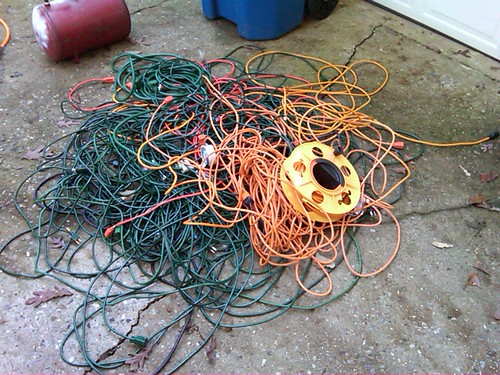pvtpublic
Whale Oil Beef Hooked
I have a pretty solid technique:





This works for garden hoses and air compressor hoses fantastically










BSNo-no-no!!!
Never operate an extension cord coiled up on a spool, it will generate heat and may even melt. Unless you only use it at a small fraction of its rated capacity.
Do that with 100' of garden hose...or a fat cable...
I've abused my cheap 100-foot extension cord for years, with little or no attention to the twisting problem, and it still conducts electricity.
Sometimes the damage is to great for the relationship to recover, but I wish you both every happiness.i'm hoping mine learns to love me again, now that i know how to treat it with respect....

Okay, but no twisting. <insert link to Twist and Shout here>
I have a couple of these and they’re great-
https://www.lowes.com/pd/CRAFTSMAN-...SJTW-Cable-Outdoor-Power-Cord-Reel/5012503247
I do/did that for my longer cables, except I just kept the lid of when using.I had an old mechanic tell me how to do this:
Get a 5 gallon bucket with a lid. Cut a 2" hole in the lid, and a 2" hole in the side of the bucket near the bottom. Thread the male end of the cord through the hole in the lid, into the bucket and out the hole in the side, about 3-4' outside the bucket. Snap the lid on and feed the rest of the cord through the hole in the lid.
I have had as much as 150 feet of of extension cord in it and never had a tangle or other problem
You are missing a bit of physics, its all about conservation of angular momentum in the end. Most manual coiling is done with the coil close to 90° to the line of the cable on the floor, while rolling is done in line with the cable.Open pondering here - if over/under is best for cable life, where does a reel fit in? It seems a reel gives the cord training just as old school coiling does. Or am I missing some physics?
that works if it's reasonably loose and cool inside, if you leave too much inside and it starts to behave like a tightly packed coil it might melt/catch fire.I had an old mechanic tell me how to do this:
Get a 5 gallon bucket with a lid. Cut a 2" hole in the lid, and a 2" hole in the side of the bucket near the bottom. Thread the male end of the cord through the hole in the lid, into the bucket and out the hole in the side, about 3-4' outside the bucket. Snap the lid on and feed the rest of the cord through the hole in the lid.
I have had as much as 150 feet of of extension cord in it and never had a tangle or other problem
Thanks. I thought there was a good reason.You are missing a bit of physics, its all about conservation of angular momentum in the end. Most manual coiling is done with the coil close to 90° to the line of the cable on the floor, while rolling is done in line with the cable.
With a coil action, the longitudinal rotation that results from the coiling process either gets bigger and causes the twisting of the cable, or it has to be countered by rotating in the opposite direction every alternate coil (the over/under process). If the cable is short enough, or you are sufficiently patient, you can counter the rotation by letting the as-yet uncoiled length twist in the opposite direction too. On long cables, this is f***ing annoying to do manually.
With a reel, any rotation is expended around the axle of the reel and therefore does not build up. You can actually coil a cable by hand without twisting if you roll it up into the coil along the line of the cable by rotating the coil in your hands around the invisible center.
There may be videos on Youtube about this.
I should have mentioned that it is loosely packed inside, and I have never used it for anything that drew very much current--hedge trimmers and such. Someone else's experience could be different.that works if it's reasonably loose and cool inside, if you leave too much inside and it starts to behave like a tightly packed coil it might melt/catch fire.
Twist the wire opposite directions each coil.. Always. I guess excepting the 3-9ft cords. The coils edit:winders are OK if you pull them all the way out every time.
I suppose I have never tried the chain sinnet of coiling rope though(kind of like the way grain bags are sealed.. pull one end and it coils out nicely, like it ever works..)
like it ever works..)